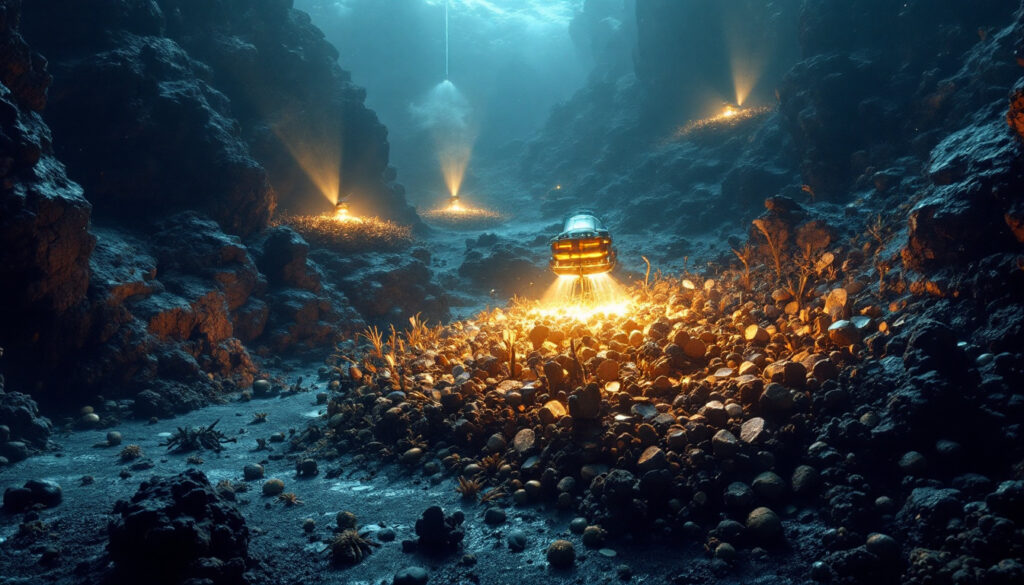What is Deep-Sea Mining and How Does it Work?
Deep-sea mining refers to the extraction of valuable mineral deposits from the ocean floor, typically hundreds or thousands of meters below the surface. This emerging industry targets resource-rich areas where millions of years of geological processes have created concentrated deposits of valuable metals and minerals. Unlike terrestrial mining, deep-sea operations face unique challenges including extreme pressure, darkness, and accessing remote locations in international waters.
The process targets three main types of underwater mineral formations, each requiring specialized extraction techniques. Polymetallic nodules—potato-sized rocky concretions that form over millions of years—contain high concentrations of manganese, nickel, copper, and cobalt. These nodules lie scattered across vast abyssal plains, particularly in the Clarion-Clipperton Zone (CCZ) of the Pacific Ocean. Polymetallic sulphides form around hydrothermal vents where superheated water erupts from the seafloor, creating mineral-rich deposits containing copper, zinc, lead, gold, and silver. The third target, cobalt-rich ferromanganese crusts, accumulate on the flanks of underwater mountains (seamounts), containing valuable concentrations of cobalt, nickel, manganese, and rare earth elements.
Mining Technology and Methods
The technological approach to deep-sea mining resembles underwater harvesting more than traditional drilling. For polymetallic nodules, which represent the current primary focus, specialized collection vehicles traverse the seafloor like underwater tractors. These remotely operated vehicles (ROVs) gather nodules along with the top layer of sediment using combinations of suction devices, scoops, and conveyor systems.
Once collected, the nodule-containing sediment mixture travels through a riser system—essentially a giant tube—that connects to a surface vessel. This vertical transport system, which can extend several kilometers through the water column, relies on hydraulic pumps to move the material upward. Aboard the surface vessel, initial processing separates nodules from sediment and seawater. The waste materials, including disturbed sediments and organic matter, are then typically returned to the marine environment, often discharged at mid-water depths.
"The technology resembles giant vacuum cleaners operating on the seafloor," explains Dr. Hjalmar Thiel, a marine biologist who has studied deep-sea ecosystems for decades. "But unlike household vacuums, these systems disturb several centimeters of sediment that has accumulated over thousands of years, creating plumes that can travel for kilometers."
Key Target Areas
The Clarion-Clipperton Zone (CCZ) has emerged as the epicenter of deep-sea mining interest. This vast region, spanning approximately 4.5 million square kilometers between Hawaii and Mexico, contains the world's largest known concentration of polymetallic nodules. The International Seabed Authority (ISA) has already issued 17 exploration contracts covering roughly 1 million square kilometers of the CCZ—an area comparable to the size of Ethiopia.
The concentration of nodules in prime CCZ locations can reach up to 15 kilograms per square meter, with average metal content of 29% manganese, 1.3% nickel, 1.1% copper, and 0.2% cobalt. Experts estimate the CCZ contains more nickel, cobalt, and manganese than all land-based reserves combined. The Mid-Atlantic Ridge and the Central Indian Ocean Basin represent other significant target zones, particularly for hydrothermal vent deposits.
Recent seafloor mapping utilizing advanced sonar technology has identified over 600 new seamounts potentially containing cobalt-rich crusts, dramatically expanding the potential resource base. As The Metals Company CEO Gerard Barron noted in a 2023 investor briefing, "We're talking about enough critical minerals in the CCZ alone to electrify the entire global vehicle fleet several times over."
Why is Deep-Sea Mining Being Considered?
The push toward deep-sea mining stems primarily from the projected mineral shortfall facing the global transition to renewable energy technologies. As countries worldwide commit to aggressive carbon reduction targets, the demand for metals necessary for clean energy infrastructure is skyrocketing beyond current supply capabilities.
Growing Demand for Critical Minerals
According to World Bank projections, global demand for critical minerals could increase by an astonishing 400-600% by 2050. This dramatic rise is driven by the materials-intensive nature of renewable energy technologies compared to fossil fuel infrastructure. A single electric vehicle requires six times more minerals than a conventional car, containing approximately 8 kilograms of lithium, 35 kilograms of nickel, and up to 15 kilograms of cobalt depending on battery chemistry.
Wind turbines demand large quantities of copper, zinc, and rare earth elements, with offshore installations requiring up to 15 tons of these minerals per megawatt of capacity. Solar panel production consumes significant amounts of copper, silver, and specialized semiconductor materials. Energy storage systems, essential for grid stabilization with intermittent renewables, further intensify mineral requirements.
As Robert Friedland, founder of Ivanhoe Mines, bluntly stated at a 2023 industry conference, "The inconvenient truth is that we cannot build a green future with the minerals we're currently producing. The math simply doesn't work."
Potential Advantages Over Land-Based Mining
Proponents argue that deep-sea mining could address several problematic aspects of conventional terrestrial mining. Traditional mining operations often involve significant deforestation, with mineral extraction responsible for approximately 7% of global forest loss in the past decade. Open-pit mines frequently contaminate freshwater systems with acid drainage and heavy metals, while underground operations face safety challenges and often rely on exploitative labor practices.
Deep-sea mining theoretically avoids direct human displacement, cultural heritage destruction, and community conflicts that frequently accompany land-based projects. The absence of soil overburden means less waste material per ton of ore, potentially reducing the overall environmental footprint. Additionally, nodules contain multiple target metals in a single deposit, whereas terrestrial mining typically focuses on single commodities, requiring separate operations for different minerals.
The regulatory framework governing deep-sea mining in international waters falls under a unified body—the International Seabed Authority—potentially offering more consistent environmental standards than the patchwork of national regulations that oversee land-based operations.
Mineral Abundance in Deep Ocean
The mineral wealth of the deep ocean represents one of Earth's last great untapped resources. Geological surveys estimate the CCZ alone contains 21 billion tons of polymetallic nodules with higher concentrations of target metals than most terrestrial deposits. A square kilometer of nodule-rich seafloor may contain more cobalt than a typical land-based mine produces in its entire operational lifetime.
Hydrothermal vent fields host some of the richest mineral concentrations on Earth, with copper grades averaging 8-10%—significantly higher than the 0.5-1% typical in land-based mines. Similarly, cobalt-rich crusts on seamounts may contain cobalt concentrations up to ten times higher than terrestrial deposits.
DeepGreen Metals (now The Metals Company) claims that processing four million tons of dry nodules annually could produce 85,000 tons of nickel, 7,500 tons of cobalt, 13,000 tons of manganese, and 65,000 tons of copper—enough to manufacture batteries for 4.8 million electric vehicles per year.
What is the Current Status of Deep-Sea Mining?
Deep-sea mining stands at a critical regulatory and technological inflection point. While no commercial-scale operations have begun, both the governance framework and technical capabilities are rapidly developing toward potential deployment. Understanding the geology of ore deposits is crucial for developing these resources responsibly.
Regulatory Framework
The International Seabed Authority (ISA), established under the 1982 United Nations Convention on the Law of the Sea (UNCLOS), holds exclusive authority to manage mineral resources in areas beyond national jurisdiction—approximately 54% of the global seafloor. The ISA operates with a dual mandate: developing these resources while ensuring effective protection of the marine environment.
Since its establishment, the ISA has issued 31 exploration contracts to various contractors, including both national entities and private corporations. However, the organization has yet to finalize the exploitation regulations necessary for commercial mining to commence. In July 2023, the ISA Council failed to reach consensus on these regulations during its Kingston, Jamaica meeting, with significant disagreements emerging over environmental protection standards and benefit-sharing mechanisms.
According to Michael Lodge, Secretary-General of the ISA, "We are working toward a mining code that balances three imperatives: ensuring environmental protection, creating a workable regulatory framework for industry, and establishing a fair system for sharing benefits with humanity as a whole."
Timeline and Current Activities
Though commercial operations haven't begun, several milestone events are shaping the industry's trajectory. In 2022, The Metals Company completed a pilot nodule collection system test in the CCZ, retrieving approximately 3,000 tons of nodules while monitoring environmental impacts. According to their public reporting, the test demonstrated that sediment plumes remained close to the seafloor and settled rapidly, though independent scientists question the limited scope and duration of monitoring.
The "two-year rule" triggered by Nauru in 2021 created a significant regulatory deadline. This provision of UNCLOS requires the ISA to consider mining applications with existing regulations by July 2023, a deadline that passed without finalized rules. This regulatory uncertainty has created a complex legal situation where applications could potentially be submitted without comprehensive environmental safeguards in place.
In January 2024, Norway initiated a process to open its territorial waters for deep-sea mineral exploration, becoming the first European nation to formally pursue marine mining. Their parliamentary approval provides a framework for companies to apply for exploration permits in the Norwegian Sea, targeting sulphide deposits along the Mid-Atlantic Ridge. Commercial extraction is unlikely before the early 2030s, as environmental baseline studies and technology development continue.
International Positions
Nations have adopted starkly different positions on deep-sea mining, reflecting diverse priorities regarding resource security, environmental protection, and economic interests. Proponents like Norway and Nauru cite critical mineral supply concerns and potential economic benefits. Norway's Minister of Energy, Terje Aasland, stated that seafloor minerals could "contribute to the green transition and create jobs and economic growth," while positioning the country as a responsible developer of marine minerals.
Conversely, countries like France, Germany, Chile, and Costa Rica have called for precautionary pauses or moratoria on deep-sea mining until scientific understanding improves. The European Parliament passed a resolution in 2021 calling for a moratorium on deep-sea mining in international waters until sufficient environmental safeguards are established. Chile's environment minister, Maisa Rojas, emphasized that "we simply don't have enough scientific information to understand irreversible impacts."
Pacific Island nations find themselves particularly divided, with Nauru championing mining development through its sponsorship of Nauru Ocean Resources Inc. (a subsidiary of The Metals Company), while Palau, Fiji, and Vanuatu have expressed strong opposition based on potential fisheries impacts and traditional connections to ocean ecosystems.
What Are the Potential Benefits of Deep-Sea Mining?
The potential advantages of deep-sea mining extend beyond merely supplying minerals, encompassing economic, geopolitical, and even certain environmental dimensions that must be weighed against significant risks. Many of these benefits align with the growing commodity super cycle driving increased interest in novel mineral sources.
Meeting Critical Mineral Demand
The most compelling argument for deep-sea mining centers on addressing the looming mineral supply gap for clean energy technologies. The International Energy Agency projects that achieving net-zero emissions by 2050 would require six times more mineral inputs in 2040 than today. Terrestrial mining faces significant challenges in scaling production to meet this demand, including declining ore grades, more remote locations, and increasing social opposition.
Deep-sea nodules contain four key battery metals (nickel, cobalt, copper, and manganese) in a single deposit, potentially simplifying supply chains. A 2023 analysis by CRU Group suggests that nodule collection could reach commercial scale faster than new terrestrial mines, which currently average 16 years from discovery to production.
"The timeline advantage is significant," explains mining economist Richard Schodde. "Many of the deep-sea deposits are already identified and require no exploration phase, potentially halving development timeframes compared to new terrestrial projects."
Environmental Considerations vs. Land Mining
Proponents argue that deep-sea mining could produce a smaller environmental footprint than expanded terrestrial mining when viewed holistically. Terrestrial mining typically requires extensive land clearing, with copper mines alone disturbing approximately 0.3 square kilometers of land surface per million tons of copper produced. By comparison, nodule collection disturbs the seafloor but eliminates deforestation, open pits, tailings dams, and acid mine drainage.
Life cycle assessments commissioned by deep-sea mining companies suggest lower carbon emissions per ton of metal produced, primarily due to higher ore grades and reduced processing requirements. A 2020 study published in the Journal of Cleaner Production calculated that nodule-derived metals could reduce CO₂ emissions by 70-80% compared to land-based equivalents, though critics question some baseline assumptions in these analyses.
Water usage represents another potential advantage, with nodule processing requiring significantly less freshwater than conventional mining—a crucial consideration as climate change exacerbates water scarcity in many mining regions.
Social and Economic Factors
The ISA's governance structure provides for revenue sharing from deep-sea mining in international waters, with benefits theoretically distributed to developing nations under the "common heritage of mankind" principle. This contrasts with terrestrial mining, where benefits often flow primarily to mining companies and host governments, with local communities frequently bearing disproportionate environmental costs.
The potential for deep-sea mining to reduce reliance on minerals from regions with problematic human rights records represents another social dimension. More than 70% of cobalt currently comes from the Democratic Republic of Congo, where artisanal mining often involves child labor and hazardous working conditions. Nickel mining in countries like Indonesia frequently displaces indigenous communities and contributes to deforestation.
As former NASA astronaut Kathryn Sullivan noted in her testimony to the U.S. Senate, "There are ethical dimensions to all resource decisions. The minerals to power our phones and cars currently come from somewhere, often with significant human costs that remain conveniently invisible to consumers."
What Are the Environmental Risks of Deep-Sea Mining?
Despite potential benefits, deep-sea mining presents profound environmental concerns, many stemming from the unique vulnerability of deep-ocean ecosystems and scientific uncertainties about impact severity and recovery potential. Addressing these mining ESG challenges will be crucial for industry development.
Direct Impacts on Marine Life
The most immediate environmental consequence involves physical destruction of seafloor habitats. Collection vehicles directly crush less mobile organisms and remove nodules that serve as essential habitat for 70-90% of species in nodule fields. These organisms include deep-sea corals, sponges, and numerous invertebrates that have evolved specifically to colonize nodule surfaces.
Dr. Craig Smith, a deep-sea ecologist at the University of Hawai'i who has studied the CCZ for decades, explains: "Many species in these regions grow extremely slowly—some deep-sea corals may be thousands of years old. When destroyed, these communities may require millions of years to recover, if they recover at all."
Sediment plumes generated by mining vehicles represent another major concern. As collection machines disturb the seafloor, they suspend fine sediments that can travel kilometers from mining sites, potentially smothering filter-feeding organisms far beyond the direct mining footprint. Recent modeling studies suggest these plumes could affect areas 5-10 times larger than the actual mining site, potentially impacting 500-1,000 square kilometers from a single operation.
The discharge of processing water from mining vessels introduces additional risks. This wastewater—containing fine sediment particles, heavy metals, and potentially warmer temperatures—would be released into mid-water communities. Scientists from the Massachusetts Institute of Technology found that plumes from discharge could spread over 45 kilometers horizontally, potentially disrupting the mesopelagic zone or "twilight zone," which contains the world's largest fish biomass and plays crucial roles in marine food webs and carbon cycling.
Long-term Ecosystem Disruption
Deep-sea ecosystems have evolved under remarkably stable conditions—constant darkness, stable temperatures, and minimal disturbance. Mining would introduce unprecedented light and noise pollution to these environments. Recent research from the University of Exeter demonstrates that deep-sea organisms show strong behavioral responses to artificial light, which could disrupt feeding, reproduction, and predator-prey interactions across extensive areas.
The acoustic impact of mining operations poses particular concerns for marine mammals. Sound travels efficiently through water, and mining noise could propagate hundreds of kilometers, potentially interfering with whale communication and navigation. A 2023 study published in Science found that blue whales stop feeding when exposed to industrial noise levels comparable to those expected from mining operations.
The extremely slow recovery rates of deep-sea ecosystems dramatically amplify the significance of these impacts. Polymetallic nodules grow at rates of 1-10 millimeters per million years, meaning that habitat removal is effectively permanent on human timescales. Even sediment disturbance creates long-lasting changes; experimental tracks created on the seafloor in the 1980s remain clearly visible today, showing minimal recolonization after 40 years.
Water Column and Fishery Impacts
While attention often focuses on seafloor effects, impacts throughout the water column could prove equally significant. Many commercially important fish species migrate vertically through different ocean layers, potentially encountering mining plumes during these movements. Tuna stocks—economic mainstays for many Pacific Island nations—could face disruption to their feeding patterns and migration routes.
Scientists from the National Oceanic and Atmospheric Administration (NOAA) have identifie
Ready to Spot the Next Major Mineral Discovery?
Discovery Alert's proprietary Discovery IQ model delivers instant, actionable alerts on significant ASX mineral discoveries, giving you the edge needed for informed investment decisions. Explore historical returns of major mineral discoveries that have generated substantial market returns by visiting Discovery Alert's dedicated discoveries page and begin your 30-day free trial today.




